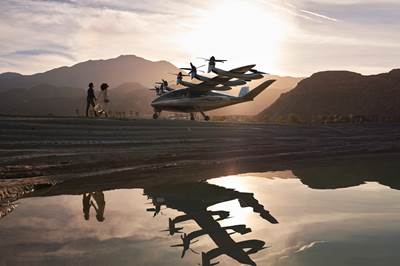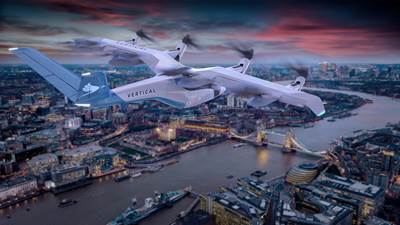UC San Diego earns NASA grant for eVTOL design tool development
Three-year project to develop open-source simulation and optimization tools to enable companies to rapidly design eVTOL vehicle concepts.

An artist’s conception of an urban air mobility environment. Photo Credit: NASA/Lillian Gipson
Note: This article was provided by the University of San Diego and originally reported by Katherine Connor.
It was reported on Feb. 12 that a team of engineers led by the University of California (UC) San Diego have received a $5.8 million University Leadership Initiative (ULI) grant from NASA to create computational design tools that will help U.S. companies develop more efficient electric vertical takeoff and landing (eVTOL) aircraft designs faster.
“This project is part of a growing field called urban air mobility (UAM), an exciting vision enabling point-to-point, on-demand air travel within densely populated areas,” says John Hwang, professor of mechanical and aerospace engineering at the Jacobs School of Engineering at UC San Diego and principal investigator for the project. “We will combine multidisciplinary computational models of UAM vehicles and advanced design optimization algorithms to develop methods and tools for rapidly designing safe, quiet and affordable vehicle concepts.”
This three-year project will result in a set of open-source simulation and optimization tools that companies can use to design the optimal eVTOL aircraft according to needs and requirements. Given several input parameters such as number of passengers, desired cruise speed and range requirement, these tools will reportedly allow engineers to determine the optimal number and shape of rotors, wing shape, structural design, propulsion system sizing and other design aspects that yield the most cost-efficient vehicle while ensuring it is safe and operates quietly. In addition, the researchers will use these tools to perform vehicle configuration trade studies on safety, noise and cost, to help companies make design decisions.
“Given a computational model, state-of-the-art design optimization algorithms can efficiently search for the optimal values of up to tens of thousands of design parameters that minimize or maximize some specified objective, such as vehicle operating cost,” adds Hwang. “We will develop models for all aspects of the aircraft — such as aerodynamics, structures, acoustics, battery and motor performance — and leverage these optimization algorithms to navigate the most complex and unintuitive aspects of the eVTOL aircraft design problem.”
Early rollout of this new class of vehicles is expected within five years, with a market study commissioned by NASA estimating these services will be profitable by the 2030s. In fact, United Airlines and startup Archer Aviation (Palo Alto, Calif., U.S.) recently signed a deal to purchase 200 of these eVTOL aircraft, expected to debut in 2024.
The team, led by Hwang, is one of five academic groups that received the ULI award from NASA. ULI was created to initiate a new type of interaction between NASA’s Aeronautics Research Mission Directorate and U.S. universities, with academic researchers taking the lead on their own research projects that further NASA’s mission.
In addition to Hwang, the team includes UC San Diego engineers David Kamensky, Alicia Kim and Shirley Meng. The team also includes Seongkyu Lee from UC Davis; Chris Mi from San Diego State University; Andrew Ning from Brigham Young University; Jeffrey Chambers and Adam Grasch from Aurora Flight Sciences (Manassas, Va., U.S.); and Tyler Winter of M4 Engineering (Long Beach, Calif., U.S.). In all, the researchers bring expertise in computational modeling and optimization, topology optimization, batteries, acoustics, electric motors, aerodynamics, composite materials and concept design.
Key aspects of the ULI include a focus on transitioning the research results to industry or government partners to bring them to market; providing research opportunities for students; and promoting greater diversity in the aeronautics field through increased participation of underrepresented groups in engineering.
This project will have an industry advisory board consisting of both established aircraft companies and eVTOL startups. The team will also institute an aeronautics internship program for students, to enhance and coordinate recruiting and mentoring of undergraduate student researchers across all four universities involved. The internship will be run in partnership with the Academic Enrichment Program at UC San Diego, which has experience managing internship programs for first-generation, low-income and underrepresented students in engineering.
Related Content
Plant tour: Airbus, Illescas, Spain
Airbus’ Illescas facility, featuring highly automated composites processes for the A350 lower wing cover and one-piece Section 19 fuselage barrels, works toward production ramp-ups and next-generation aircraft.
Read MoreCeramic matrix composites: Faster, cheaper, higher temperature
New players proliferate, increasing CMC materials and manufacturing capacity, novel processes and automation to meet demand for higher part volumes and performance.
Read MoreMFFD longitudinal seams welded, world's largest CFRTP fuselage successfully completed
Fraunhofer IFAM and partners have completed left and right welds connecting the upper and lower fuselage halves and sent the 8×4-meter full-scale section to ZAL for integration with a cabin crown module and testing.
Read MoreDevelopment of a composite liquid hydrogen tank for commercial aircraft
Netherlands consortium advances cryogenic composites testing, tank designs and manufacturing including AFP, hybrid winding, welding of tank components and integrated SHM and H2 sensors for demonstrators in 2025.
Read MoreRead Next
Archer to be listed on NYSE through Atlas Crest Investment merger
Business combination agreement expected to provide approximately $1.1 billion of gross proceeds. United Airlines to purchase $1 billion worth of Archer’s eVTOL aircraft.
Read MoreSolvay, Vertical Aerospace expand on UAM agreement
Composite materials supplier Solvay Composite Materials and urban air mobility (UAM) manufacturer Vertical Aerospace offer details about materials, process use in VA-1X aircraft.
Read MoreNext-gen fan blades: Hybrid twin RTM, printed sensors, laser shock disassembly
MORPHO project demonstrates blade with 20% faster RTM cure cycle, uses AI-based monitoring for improved maintenance/life cycle management and proves laser shock disassembly for recycling.
Read More


























